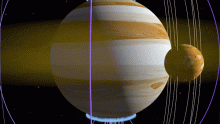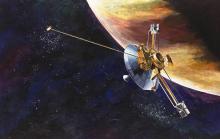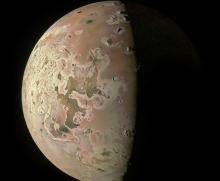Listen to today's episode of StarDate on the web the same day it airs in high-quality streaming audio without any extra ads or announcements. Choose a $8 one-month pass, or listen every day for a year for just $30.
You are here
Jupiter at Opposition III
Jupiter travels with a big entourage, including almost 80 known moons, several dark rings, and two clumps of asteroids.
The asteroids are known as Trojans. One clump orbits 60 degrees ahead of Jupiter, while the other is 60 degrees behind it. Each group contains thousands of asteroids. But the leading group has about half again as many as the trailing one. That difference could be telling us something about the formation of Jupiter itself.
Most models suggest there shouldn’t be any difference in the two clumps at all. So a team of European astronomers ran its own simulations. The team found that the only way to match what we see is if Jupiter was born far from its current location.
The simulations showed that Jupiter began as an Earth-sized ball of ice and rock. It was about four times farther from the Sun than it is today. Interactions with a disk of leftover gas and dust around the Sun caused the young planet to spiral inward. It migrated for about 700,000 years, adding to its heft by pulling in chunks of ice and rock, plus lots of the gas and dust. It also locked chunks of ice and rock in its own orbit — forming the Trojans.
Other studies have also found that Jupiter moved around when it was younger. This one, though, would place its origin much farther from the Sun.
Jupiter is low in the southeast at nightfall, and looks like a dazzling star. It moves low across the south during the night, and sets at sunrise.
Script by Damond Benningfield





